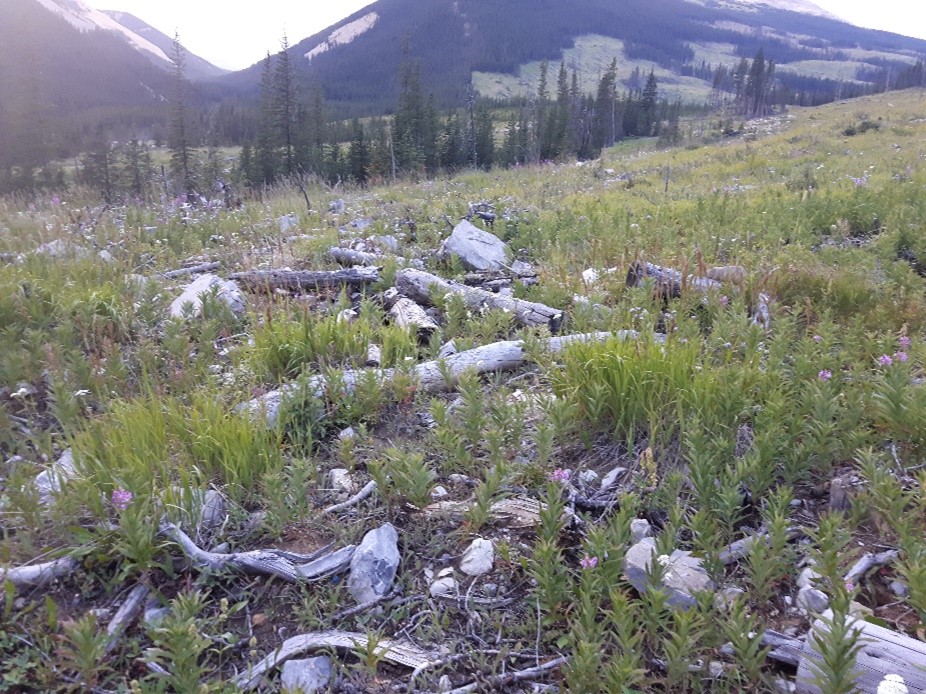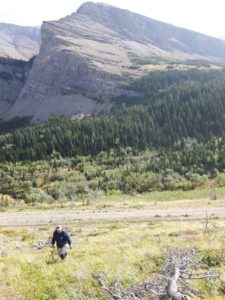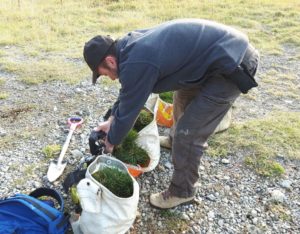
Slowly but Surely: Recovery for Alberta’s Whitebark and Limber Pine
Jodie Krakowski, Alberta Agriculture and Forestry
Nothing says “whitebark and limber pine restoration” like grunting up a steep slope loaded with heavy bags of seedlings! In late September 2020, 4400 whitebark and 1600 limber pine seedlings were planted to restore nearly 20 hectares of priority restoration areas in Alberta Crown land. These sites had high blister rust infection and mortality, with populations that are at risk of losing their ecological function without restoration planting of seedlings from trees selected for disease resistance.
All that sweat and dirt represents the culmination of years of work.
- First, stands are surveyed to find areas with high blister rust infection. Over 80% is preferred. Unfortunately, Alberta has lots of those!
- Then, plus trees that appear healthy or show signs of tolerance are identified, permanently tagged and documented.
- The stars must align so years when there is a good cone crop, resources and trained people are available to safely access and climb each tree twice to cage and then collect the cones.
- The seed is then manually extracted after cones are dried, and processed keeping each tree separate.
- The seed is then either stored for gene conservation, sent for disease resistance screening to a special facility, or sent to a nursery for a long, complex stratification process before sowing and growing.
- After 2 growing seasons, the seedlings are then packed and shipped to a remote area for planting.
- The planters need to overcome tough, rocky ground, steep and obstacle-filled terrain in order to find the best microsites to help these expensive seedlings survive.
- Monitoring plots are established to evaluate field performance and health of planted seedlings and compare screening results to field results.
Eventually these seedlings will contribute their own seeds, increasing the rust resistance of the population. Southwestern Alberta, in the heart of the Crown of the Continent, has extremely high levels of infection and mortality. Blister rust has been observed in whitebark and limber pine trees in the region for close to a century. Populations will lose their ecological function and connectivity without restoration to increase the population density and cone production.
While this may seem daunting, year by year, site by site, the cumulative results lead to recovery. There is no quick fix, but thanks to many partners, all the pieces of the provincial whitebark and limber pine recovery plan are being implemented.
The long term, remote, costly nature of working with these species compels a careful balance between being pragmatic, opportunistic, and strategic. Between cones, funding, provincial and regional recovery priorities, logistics, and available resources, the options must be weighed each year, and for multi-year planning. There is always lots to do, and we expect the positive momentum will continue!
In 2020, partners supporting restoration included: Government of Alberta – Alberta Agriculture and Forestry and Alberta Environment and Parks, Environment and Climate Change Canada, the Whitebark Pine Ecosystem Foundation of Canada, Spray Lakes Sawmills, Riversdale Resources Limited, Gass + Associates, Hailey Mizera, Leor Katzev, Megan Evans, Colin McManus.



